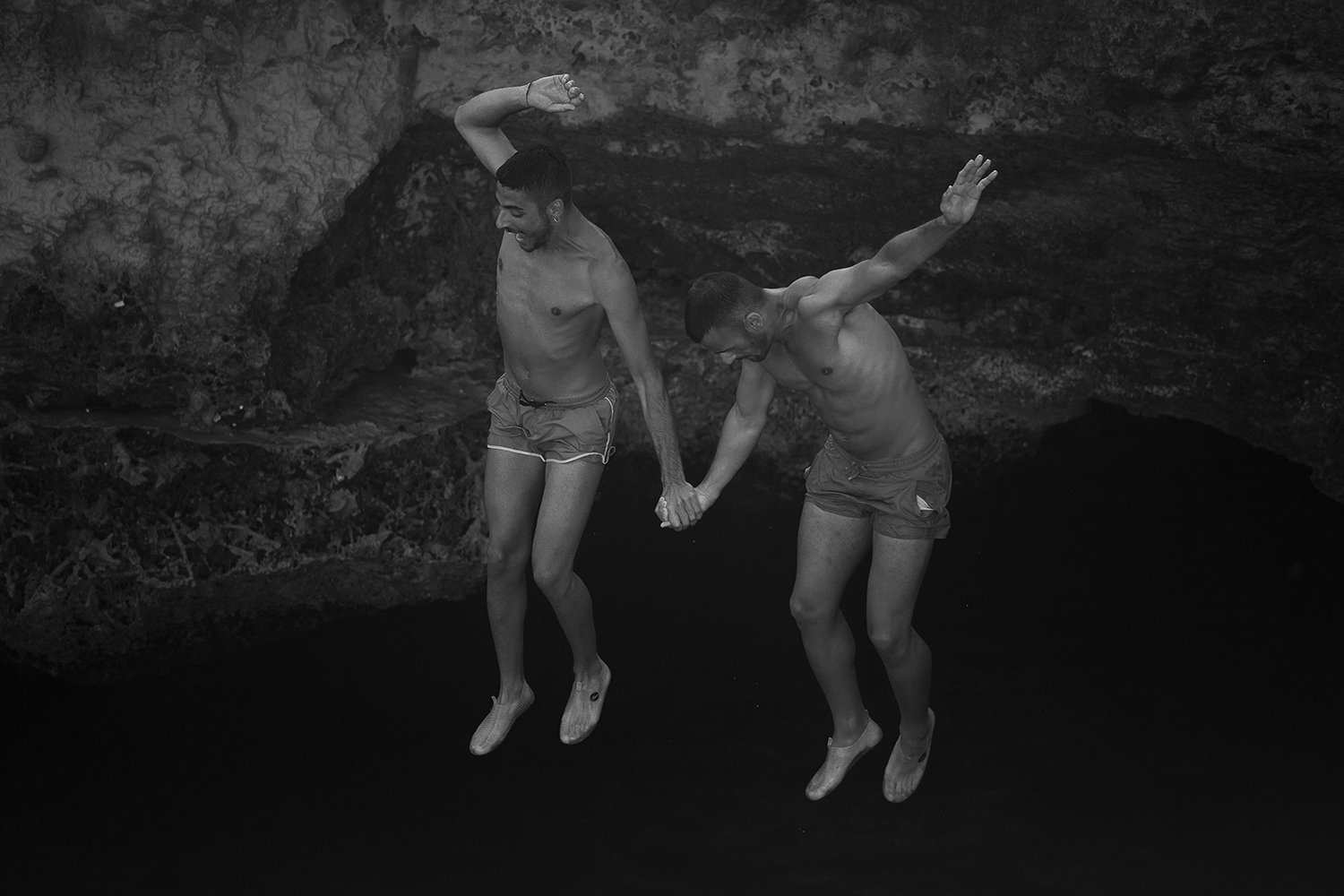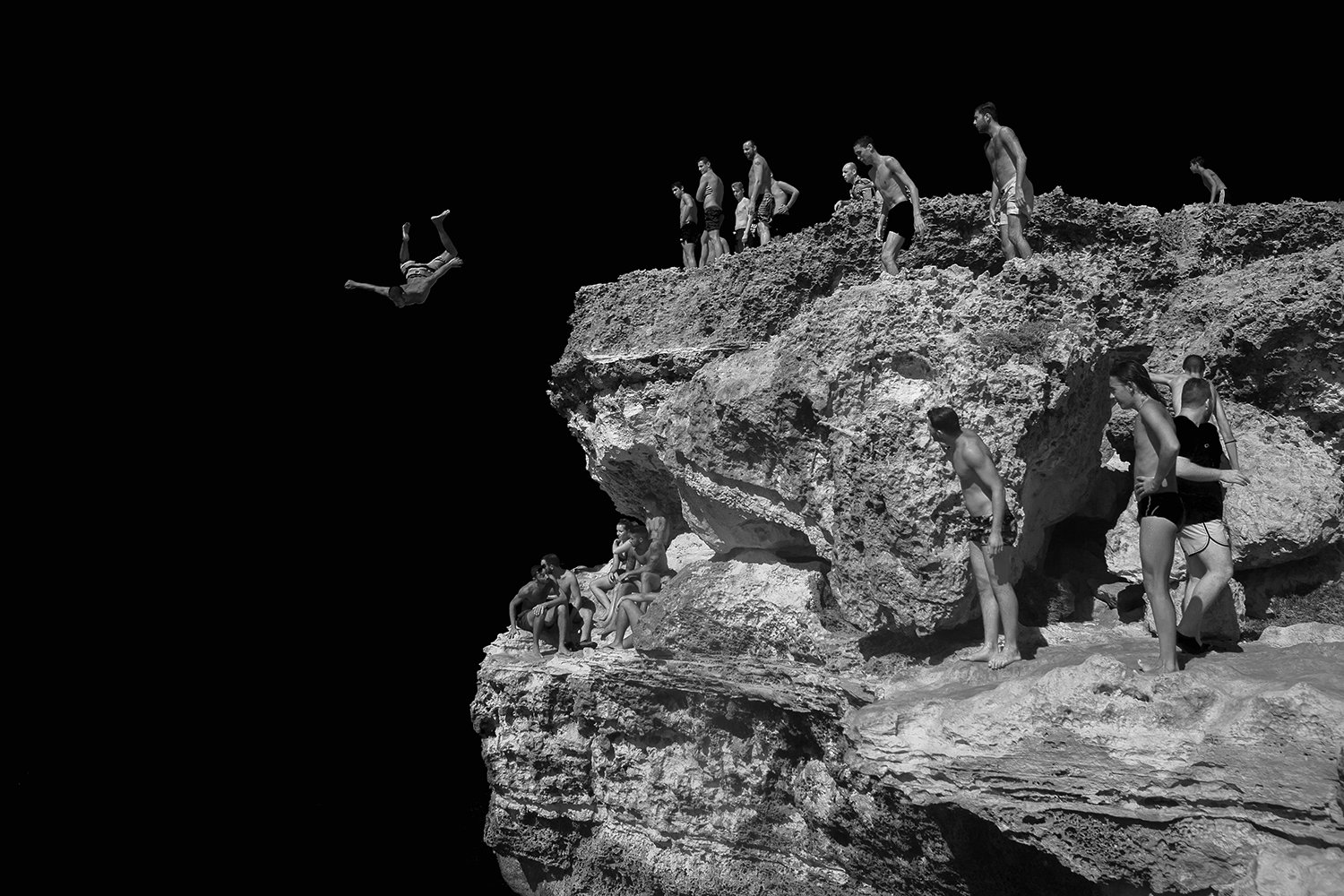The Art of Leaping in the Dark
The act of diving, whatever the era or geographical area, has always brought out ambiguous feelings in people: of fascination, affirmation and carefreeness, but also of fear and loss of control of one’s body in space; in some cases becoming a challenge aimed at symbolising the overcoming of a limit or even a rite of passage.
The Archaeological Museum in Paestum is home to a Greek tomb, found in a necropolis, with a fresco depicting an unusual subject: a naked young man diving into the sea; a metaphor of the passage from life to death. A dive was therefore used as a perfect allegory of life, symbolising the passage from a known world, the earth, to an unknown one, the sea. Between land and sea, the air transforms the fall into an exemplary feat, into an athletic pose, into art.
The dive can also be an initiation rite. On the island of Pentecost, in the Melanesian archipelago of Vanuatu, a ritual known as Naghol, meaning “leap into the void", is undertaken by teenagers, taking its inspiration from the sport of bungee jumping. Every year, during the yam harvest (the tuber represents the main food resource of the island), dozens of young people throw themselves off a tower that is over 25 metres high, with their ankles secured by vines. A spectacular initiation ceremony focused on courage: in order to become men, males must prove their worth with a leap into the void and thus ingratiate themselves with fate. Each jump is accompanied by screams and prolonged applause.
These concepts represent the springboard for the photographic project, where the act of diving becomes a metaphor for a leap into the unknown and for transition, from which the protagonists emerge reinvigorated, transformed, freed.
In recent years, I have photographed divers in some parts of the Salento area, such as the Grotta della Poesia, a natural cave shaped by the Adriatic Sea in the rocky coast over the centuries. It is here, in this sort of natural pool, despite the ban on swimming due to the geomorphological danger posed by the cliff, that the population comes to experience what has become a collective ritual, in which the fear of the void is faced with the support and encouragement of people waiting for their moment to dive. The fear of the individual is shared and, at times, the wait to dive into the void can even last for minutes, during which there is a respectful silence and, following the leap, collective applause.
In this project, I worked by subtraction: attenuating the summer setting and intensifying the action, the performance of the bodies in flight, carrying out a process of abstraction, inviting the observer to dwell on the three structural elements in the series: the human figure in the void, with postures that can be deformed by instinct, the air that this moves, and finally the rock, the prehistoric element, in the same way that man’s tension towards the unknown, experimentation of the unknown, his desire to “go beyond” is prehistoric - synonymous here with archetypal.
L'arte di Saltare nel Buio
Il gesto del tuffo, in qualunque epoca e area geografica, ha sempre esercitato sentimenti ambigui nelle persone: di fascinazione, affermazione e spensieratezza, ma anche di timore e perdita di controllo del proprio corpo nello spazio; in certi casi diventando una sfida volta a simboleggiare il superamento di un limite o addirittura di un rito di passaggio.
Nel Museo Archeologico di Paestum è esposta una tomba greca, rinvenuta in una necropoli, con un affresco che rappresenta un soggetto insolito: un giovane nudo che si tuffa nel mare; metafora del passaggio dalla vita alla morte. Come perfetta allegoria della vita è stato quindi usato un tuffo, simbolo del passaggio da un mondo conosciuto, la terra, a uno sconosciuto, il mare. Fra terra e mare, l’aria trasforma la caduta in un gesto esemplare, in una posa atletica, in arte.
Il tuffo può essere anche un rito di iniziazione. Sull’Isola di Pentecoste, nell’arcipelago melanesiano di Vanuatu, viene praticato un rituale dagli adolescenti, il Naghol, cioè “salto nel vuoto”, a cui si ispira lo sport del bungee jumping. Ogni anno, nel periodo della raccolta dell’igname (il tubero che rappresenta la principale risorsa alimentare dell’isola), decine di giovani si lanciano da una torre alta oltre 25 metri con le caviglie assicurate da liane. Una spettacolare cerimonia di iniziazione incentrata sul coraggio: i maschi, per diventare uomini, devono dimostrare il loro valore con un salto nel vuoto e ingraziarsi così la sorte. Ogni salto è accompagnato da urla e prolungati applausi.
È da questi concetti che parte il progetto fotografico, dove il gesto del tuffo diventa metafora di un salto nell'ignoto e di transizione, da cui i protagonisti riemergono rinvigoriti, trasformati, liberati.
Negli ultimi anni ho fotografato i tuffatori in alcune aree del Salento, come la Grotta della Poesia, una cavità naturale plasmata dal mare Adriatico nella costa rocciosa, nel corso dei secoli. È qui, in questa sorta di piscina naturale, nonostante sia in vigore il divieto di balneazione a causa del pericolo geomorfologico della falesia, che la popolazione viene per sperimentare quello che è diventato un rito collettivo, in cui la paura del vuoto viene affrontata col supporto e gli incoraggiamenti delle persone che attendono il proprio momento per tuffarsi. La paura della singola persona viene condivisa e, a volte, l'attesa del lancio nel vuoto può protrarsi anche per minuti, durante i quali vige un rispettoso silenzio e, a seguito del salto nel vuoto, un applauso collettivo.
In questo progetto ho lavorato per sottrazione: attenuando il contesto estivo ed esaltando l'azione, la performance dei corpi in volo, compiendo un processo di astrazione, invitando l'osservatore a soffermarsi sui tre elementi strutturali della sua serie: la figura umana nel vuoto, con posture che possono risultare deformate dall’istinto, l'aria che questa sposta e infine la roccia, l'elemento preistorico, così come preistorica - sinonimo qui di archetipica - è probabilmente la tensione dell'uomo verso il non conosciuto, la sperimentazione dell’ignoto, il suo desiderio di "andare oltre".















